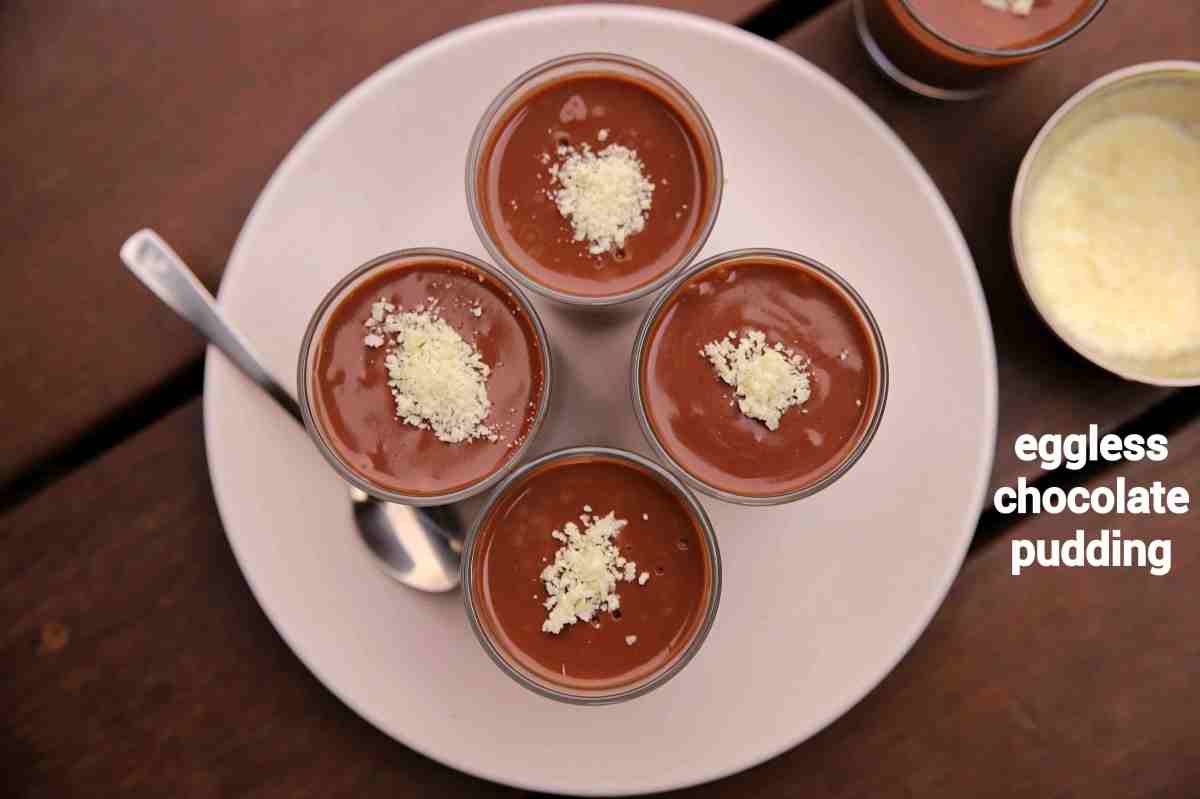Dive into a world of luscious, velvety puddings without the use of eggs! Imagine creamy textures, rich flavors, and delightful variations – all achievable without compromising on taste or indulgence. This exploration unveils the secrets to crafting decadent egg-free puddings, perfect for those with egg allergies or simply seeking exciting culinary adventures. From classic chocolate and vanilla to innovative flavor combinations, we’ll guide you through simple techniques and adaptable recipes to satisfy any sweet tooth.
This guide delves into the heart of egg-free pudding creation, providing a comprehensive collection of recipes, ingredient explorations, and dietary adaptations. We’ll uncover the versatility of key ingredients, highlighting their unique contributions to texture and flavor. Learn how to effortlessly customize these recipes to accommodate various dietary needs, including vegan, gluten-free, and dairy-free preferences. Prepare to be amazed by the diverse possibilities and the sheer deliciousness of these egg-free masterpieces.
Top 5 Egg-Free Pudding Ingredients

Creating a luscious, creamy pudding without eggs requires careful ingredient selection. These five ingredients form the backbone of many delicious egg-free pudding recipes, offering a delightful balance of texture and flavor. Their versatility allows for endless customization, catering to diverse palates and dietary needs.
Ingredient Contributions to Texture and Flavor
The success of an egg-free pudding hinges on the right combination of ingredients that mimic the binding and richness provided by eggs. Each ingredient plays a crucial role in achieving the desired creamy texture and sweet flavor profile. Cornstarch, for example, acts as a thickening agent, while coconut milk contributes richness and a subtle tropical note. Understanding the individual roles of these ingredients is key to creating a perfect pudding.
Five Key Egg-Free Pudding Ingredients
| Ingredient | Texture Contribution | Flavor Contribution | Nutritional Profile (per 100g) |
|---|---|---|---|
| Cornstarch | Provides thickening and creates a smooth, creamy consistency. | Mildly sweet, neutral flavor; allows other flavors to shine. | Calories: ~350, Carbohydrates: ~88g, Protein: ~0g, Fat: ~0g |
| Coconut Milk | Adds richness and creaminess; contributes to a velvety texture. | Subtle sweetness and coconut flavor; can be intensified with coconut extract. | Calories: ~230, Carbohydrates: ~2g, Protein: ~2g, Fat: ~20g |
| Milk (Dairy or Plant-Based) | Provides liquid base and contributes to the overall creaminess. | Adds subtle sweetness and mild flavor; can be chosen to complement other flavors. | Varies greatly depending on type; for example, cow’s milk (100g): Calories: ~40, Carbohydrates: ~5g, Protein: ~3g, Fat: ~3g. |
| Sugar (or Sugar Substitute) | Minimal texture impact; enhances the overall mouthfeel. | Provides sweetness; type of sugar influences the final taste. | Calories: ~400, Carbohydrates: ~100g, Protein: ~0g, Fat: ~0g (for granulated sugar) |
| Vanilla Extract | Minimal texture impact; enhances the overall mouthfeel. | Provides a warm, inviting flavor; complements other ingredients beautifully. | Calories: ~300, Carbohydrates: ~75g, Protein: ~0g, Fat: ~0g (per 100ml) |
Dietary Adaptations for Egg-Free Puddings
Creating delicious and creamy egg-free puddings opens up a world of possibilities for individuals with dietary restrictions or preferences. This section explores how a basic egg-free pudding recipe can be easily adapted to accommodate vegan, gluten-free, and dairy-free diets, ensuring everyone can enjoy this delightful dessert. We’ll examine specific ingredient swaps and the resulting textural and flavor changes.
Adapting a basic egg-free pudding recipe to meet various dietary needs requires careful consideration of ingredient substitutions. The goal is to maintain the pudding’s creamy texture and appealing flavor profile while eliminating specific allergens or animal products. Below, we explore adaptations for three common dietary restrictions.
Vegan Egg-Free Pudding
To transform a standard egg-free pudding into a vegan version, the primary focus is on replacing any dairy ingredients. Many egg-free pudding recipes already utilize plant-based milks like almond milk or soy milk, but ensuring all other ingredients are also vegan is crucial. For instance, some recipes might use honey; replacing this with maple syrup or agave nectar maintains sweetness without animal products. The creamy texture can be maintained by using a thickener such as cornstarch or arrowroot powder in conjunction with the plant-based milk. Vegan butter can also substitute for regular butter if present in the recipe, providing a similar richness. The resulting pudding will have a slightly different flavor profile, often more subtly sweet and nutty depending on the chosen milk alternative, but the overall creamy texture remains largely unchanged.
Gluten-Free Egg-Free Pudding
Creating a gluten-free egg-free pudding requires careful examination of the thickening agents and any added flours or starches. Many standard egg-free pudding recipes rely on cornstarch or arrowroot powder for thickening, both of which are naturally gluten-free. However, some recipes might incorporate all-purpose flour, which would need replacing with a gluten-free blend such as a mix of rice flour, tapioca starch, and potato starch. This substitution might slightly alter the pudding’s texture, potentially resulting in a slightly less smooth consistency. However, the flavor profile should remain largely unaffected. Careful attention to the recipe and using a high-quality gluten-free flour blend is crucial for optimal results.
Dairy-Free Egg-Free Pudding
Adapting an egg-free pudding to be dairy-free is relatively straightforward, given that many egg-free recipes already utilize plant-based milks. The focus here is on replacing any dairy-derived ingredients such as butter or cream. Plant-based butter alternatives, such as those made from coconut oil or soy, can provide a similar richness. Coconut milk, for example, can be used to create a luxuriously creamy pudding, offering a unique coconut flavor that complements many pudding recipes. The texture might be slightly different, depending on the specific dairy-free alternative used; coconut milk, for example, can impart a slightly thicker consistency than cow’s milk. The flavor will, of course, reflect the chosen dairy-free alternative. Using a high-quality dairy-free milk and butter will contribute to a satisfying final product.
Step-by-Step Guide to Making a Specific Egg-Free Pudding
This recipe details the creation of a luscious Coconut Mango Pudding, a vibrant and refreshing dessert perfect for warm weather or any occasion. The creamy texture is achieved without the use of eggs, relying instead on the natural richness of coconut milk and the thickening power of cornstarch. The result is a subtly sweet and intensely flavorful pudding that’s both elegant and easy to make.
Ingredients for Coconut Mango Pudding
The following ingredients are essential for achieving the desired texture and taste profile of this delightful pudding. Precise measurements ensure consistency and a perfectly balanced flavor.
- 1 (13.5 ounce) can full-fat coconut milk, well-shaken
- 1/2 cup granulated sugar
- 1/4 cup cornstarch
- 1/4 teaspoon salt
- 1 cup mango puree (approximately 2 ripe mangoes, blended)
- 1 teaspoon vanilla extract
- Optional: Toasted coconut flakes for garnish
Preparing the Coconut Milk Mixture
This initial step involves creating a smooth, homogenous base for the pudding. The careful blending of ingredients at this stage prevents lumps and ensures a creamy final product.
First, in a medium saucepan, whisk together the coconut milk, sugar, cornstarch, and salt until completely smooth. The mixture will appear slightly thick and opaque. Next, place the saucepan over medium heat, stirring constantly with a whisk. As the mixture heats, it will gradually thicken and begin to simmer. Continue stirring diligently to prevent scorching. The mixture will transform from a thin, milky liquid into a creamy, slightly glossy consistency. This process takes approximately 5-7 minutes.
Incorporating Mango Puree and Vanilla
The addition of mango puree and vanilla extract introduces the vibrant flavor profile of this pudding. Gentle incorporation prevents curdling and ensures a smooth, even distribution of flavor throughout the dessert.
Once the coconut milk mixture has thickened, remove the saucepan from the heat. Stir in the mango puree and vanilla extract until fully combined. The vibrant orange hue of the mango will be clearly visible, creating a beautiful contrast against the creamy white coconut milk base. The mixture should now have a noticeably thicker consistency, resembling a custard.
Chilling and Serving the Coconut Mango Pudding
The final stage involves chilling the pudding to allow it to set completely and develop its full flavor. The cooling process transforms the warm, creamy mixture into a delightfully chilled dessert.
Pour the coconut mango mixture into individual serving dishes or a larger bowl. Cover and refrigerate for at least 2 hours, or preferably overnight. As the pudding chills, it will thicken considerably, becoming firm enough to hold its shape. Before serving, garnish with toasted coconut flakes for added texture and visual appeal. The final product will be a vibrant orange-hued pudding with a smooth, creamy texture and a delicate balance of sweet coconut and tangy mango flavors.
Creating delectable egg-free puddings is now within everyone’s reach. This journey through classic and innovative recipes has showcased the boundless potential of egg-free baking. By understanding the key ingredients and mastering simple techniques, you can confidently craft creamy, flavorful puddings that will impress even the most discerning palates. So, embrace the challenge, experiment with different flavor combinations, and delight in the satisfying results of your egg-free culinary creations. The possibilities are as limitless as your imagination!
Questions and Answers
Can I make egg-free pudding ahead of time?
Yes, most egg-free puddings can be made a day or two in advance and stored in the refrigerator. This allows the flavors to meld and enhances the overall texture.
What is the best type of sweetener for egg-free pudding?
The best sweetener depends on your preference and dietary needs. Options include granulated sugar, maple syrup, agave nectar, or even stevia for a lower-calorie option. Experiment to find your favorite!
How can I thicken my egg-free pudding if it’s too runny?
If your pudding is too thin, you can gently simmer it for a few more minutes to allow the liquid to reduce. Alternatively, a cornstarch slurry (cornstarch mixed with a little cold water) can be added and stirred in to thicken the mixture.
Are all egg-free puddings naturally vegan?
Not necessarily. Many recipes utilize dairy products like milk and cream. To make a vegan pudding, ensure you use plant-based milk alternatives (like almond or soy milk) and vegan butter or oil.


